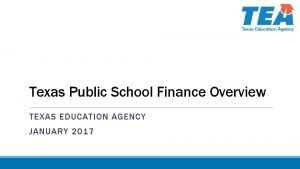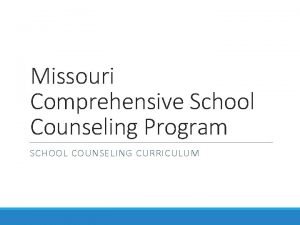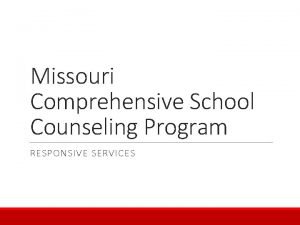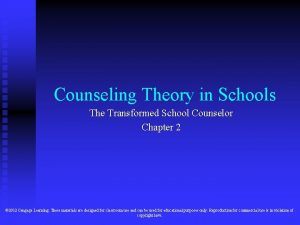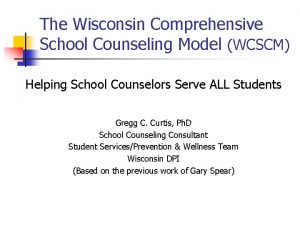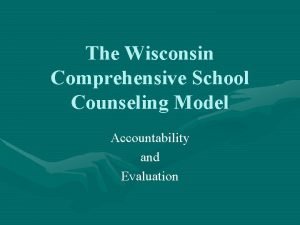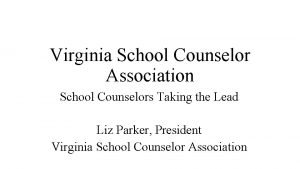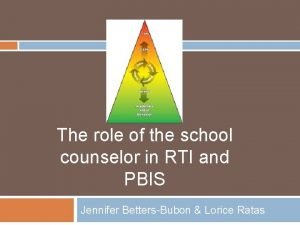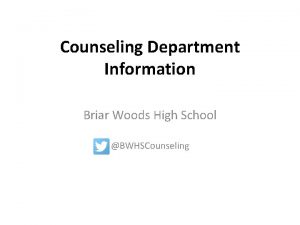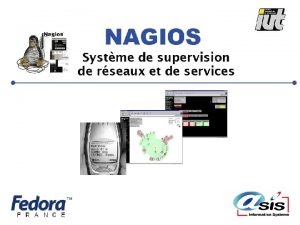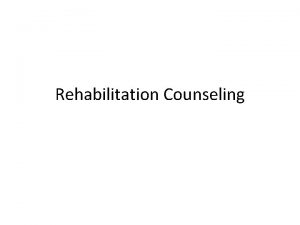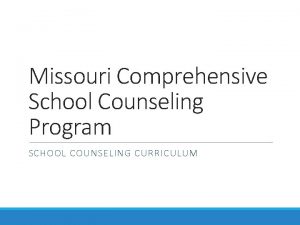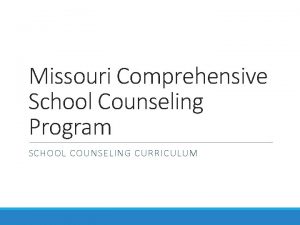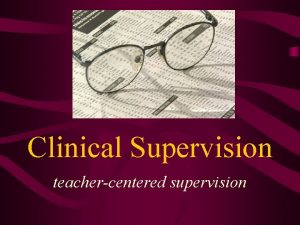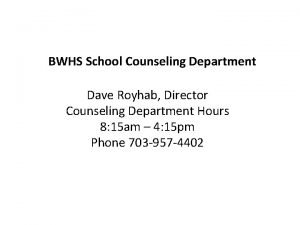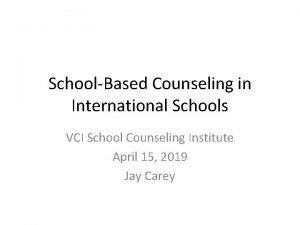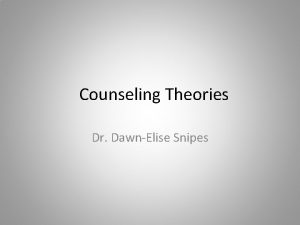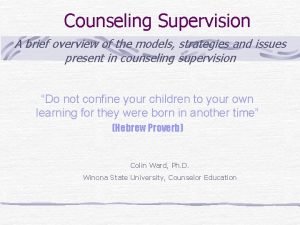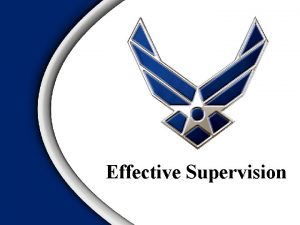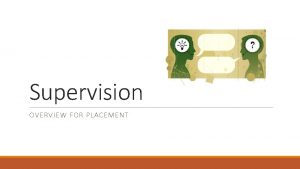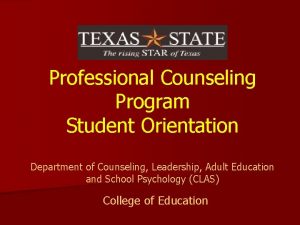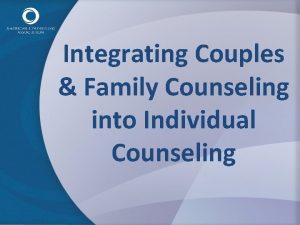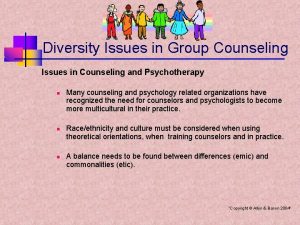School Counseling Supervision Overview What is Supervision Supervision

































- Slides: 33

School Counseling Supervision Overview

What is Supervision? Supervision is an intensive, interpersonally focused, one-to-one relationship in which one person (the supervisor) is designated to facilitate the development of competence in the other person (the supervisee) (Loganbill, Hardy, & Delworth, 1982, p. 4).

CACREP 2016 Standards Section III: SUPERVISOR QUALIFICATIONS Site supervisors have (1) a minimum of a master’s degree, preferably in counseling, or a related profession; (2) relevant certifications and/or licenses; (3) a minimum of two years of pertinent professional experience in the specialty area in which the student is enrolled; (4) knowledge of the program’s expectations, requirements, and evaluation procedures for students; and (5) relevant training in counseling supervision. Orientation, consultation, and professional development opportunities are provided by counselor education program faculty to site supervisors. Written supervision agreements define the roles and responsibilities of the faculty supervisor, site supervisor, and student during practicum and internship. When individual/triadic practicum supervision is conducted by a site supervisor in consultation with counselor education program faculty, the supervision agreement must detail the format and frequency of consultation to monitor student learning. • .

CTC 2019 Standards Qualifications, Training and Responsibilities of Site Supervisors The program assigns qualified supervisors and provides training based on the program’s design. Qualifications for supervisors must include, but are not limited to: Possession of a PPS School Counselor credential and a minimum of two years PPS experience as appropriate to the candidate’s fieldwork setting. The supervisor is responsible to undergo training in models of supervision, the SCPEs, and program fieldwork requirements and share responsibility for the quality of field experience, design of field experiences, quality of clinical progress, and assessment and verification of candidate competence.

CTC 2019 Standards (continued) Candidates must meet with their supervisor for one (1) hour of individual or one-and-one- half (1. 5) hours of small group (limit 8 candidates per group) supervision per week. 600 clock hours are required in a public Pre-K-12 school, must be supervised by a professional who holds a valid PPS credential and is also accessible to the candidate at all times while the candidate is accruing fieldwork hours. University Supervision Requirements include: One-and-one-half (1. 5) hours per week of group supervision provided on a regular schedule throughout the field experience, usually performed by a program faculty member. The program provides preparation and continuing education for field experience supervisors on program requirements, models of supervision, and the SCPEs, in collaboration with site supervisors. Site Supervisors share responsibility for the quality of field experience, design of field experiences, quality of clinical progress, and assessment and verification of candidate competence.

ACA Ethical Codes • F. 1. a. Client Welfare A primary obligation of counseling supervisors is to monitor the services provided by supervisees. Counseling supervisors monitor client welfare and supervisee performance and professional development. To fulfill these obligations, supervisors meet regularly with supervisees to review the supervisees’ work and help them become prepared to serve a range of diverse clients. Supervisees have a responsibility to understand follow the ACA Code of Ethics.

ASCA Ethical Codes • F. 4 Collaboration and Education about School Counselors and School Counseling Programs with other Professionals School counselors and school counseling program directors/supervisors collaborate with special educators, school nurses, school social workers, school psychologists, college counselors/admissions officers, physical therapists, occupational therapists and speech pathologists to advocate for optimal services for students and all other stakeholders.

Purpose of Supervision • Facilitate supervisee personal and professional development • Promote counselor competencies, knowledge and skills • Promote accountable counseling services &programs • Serve as a gatekeeper to the profession • Provide opportunities in learning about the school environment • Safeguarding clients/students as well as promoting trainee development

Supervision Best Practice Guidelines (Borders, et. al. , 2011) 1. Initiating Supervision 7. Ethical Considerations 2. Goal-Setting 8. Documentation 3. Giving Feedback 4. Conducting Supervision 5. Supervisory Relationship 6. Diversity & Advocacy Considerations 9. Evaluation 10. Supervision Format 11. The Supervisor 12. Supervisor Preparation

Initiating Supervision & Goal-Setting (Borders, et. al. , 2011) 1. Initiating Supervision: The supervisor… - reviews informed consent practices in initial supervision - explicitly states parameters for conducting supervision. - facilitates a discussion about supervision process to foster supervisory working alliance. 2. Goal-Setting: The supervisor… - co-develops specific goals for supervision with supervisee. - emphasizes goals that directly benefit counseling relationships between supervisee & client (& effectiveness of services provided). - is intentional about addressing & evaluating goals in each supervision session.

Giving Feedback & Conducting Supervision (Borders, et. al. , 2011) 3. Giving Feedback: The supervisor… - provides direct & ongoing feedback. - pays attention to multiple sources of feedback available to supervisee. 4. Conducting Supervision: The supervisor… - adheres to appropriate professional standards in establishing frequency & modality of supervision sessions. - provides a safe, supportive, & structured supervision climate. - uses a variety of supervisory interventions. - employs technology in ways that enhance supervisory process & development of supervisee. - actively evaluates course of supervision on an ongoing basis (in both academic & post-degree supervision).

Supervisory Relationship (Borders, et. al. , 2011) 5. Supervisory Relationship: The supervisor… - operates with an awareness that supervisory relationship is key to effectiveness of supervision as well as growth & development of supervisee. - intentionally engages with supervisee to facilitate development of a productive supervisory relationship & working alliance. - attends to ethical & cultural concerns that impact supervisory relationship.

Diversity & Advocacy (Borders, et. al. , 2011) 6. Diversity & Advocacy Considerations: The supervisor… - recognizes that all supervision is multicultural supervision & - infuses multicultural considerations into their supervision approach - encourages supervisees to infuse diversity & advocacy considerations in their work with clients.

Ethical Considerations (Borders, et. al. , 2011) 7. Ethical Considerations: The supervisor… - conveys to supervisee that both supervisor & supervisee are expected to adhere to ethical codes & guidelines endorsed by ACA, ACES & other ACA divisions, etc. - continually monitors their own level of competence in providing supervision & acts accordingly. - understands that client welfare is his/her first & highest responsibility & acts accordingly. - does not compromise supervisory relationship by engaging in relationships with supervisees that are considered inappropriate. - provides ongoing performance assessment & evaluation of supervisee, including supervisee’s strengths & limitations.

Documentation & Evaluation of Supervision (Borders, et. al. , 2011) 8. Documentation: The supervisor… - maintains documentation that provides a system of supervisor accountability. 9. Evaluation: The supervisor… - understands that evaluation is fundamental to supervision & accepts his/her evaluation responsibilities. - clearly communicates evaluation plan to supervisee. - encourages ongoing supervisee self-evaluation. - takes appropriate steps when remediation is necessary.

Supervision Format (Borders, et. al. , 2011) Supervision Format: The supervisor… - employs various supervision formats (individual, triadic, peer/colleague review, group supervision) that adhere to accreditation standards & regulations of credentialing bodies & that meet needs of supervisee, is appropriate to site, & adequately addresses needs of clients. - does not choose a format based on what may be convenient for supervisor (ex: saves time).

The Supervisor (Borders, et. al. , 2011) 11. The Supervisor: The supervisor… - is competent in providing counseling supervision. - can clearly describe purpose of supervision & distinguish it from counseling process as well as from administrative & program supervision. - has a collaborative relationship with additional supervisors with whom supervisee may be working (ex: program supervisor at university). - engages in self-reflection & other avenues of personal professional development. - manages supervisory relationship dynamics competently & appropriately.

The Discrimination Model of Supervision (Bernard, 1979, 1997) atheoretical conceptual framework for new supervisors provides a structure and organizational framework for supervision 3 (focus of supervision) x 3 (supervisor role) matrix areas of focus: intervention skills: observable counseling behavior conceptualization skills: ability to make sense of information, find themes, choose appropriate intervention, find outcomes/goals personalization skills: use of self, intra- and interpersonal skills supervisor roles: Teacher: instructs, models, offers feedback, evaluates Counselor: calling on supervisee to self-reflect Consultant: resource for supervisee, supporting their autonomous work

Discrimination Model: Focus Supervisee’s Intervention Skills i. e. behaviors and intervention skills; what is present and what is lacking Supervisee’s Conceptualization of the Client i. e. the ability to make sense of client data and to respond to such data Supervisee’s “personhood” i. e. the supervisee’s personal or feeling elements that contribute to the counseling process.

Discrimination Model: Supervisee Skills, Cont’d Once the skill levels & needs of the supervisee are ascertained, the supervisor is able to choose one of three supervisory roles from which to work: 1) Teacher 2) Counselor 3) Consultant It is possible that the supervisor may move between all three roles in just one supervision session.

Discrimination Model: Role Teacher i. e. the supervisor determines what the trainee should learn in order to become competent Counselor i. e. the supervisor facilitates the trainee’s self-exploration Consultant i. e. the supervisor as a resource person and one that promotes the trainee’s self-efficacy.

Discrimination Model: Supervisor Roles: Teacher… Determine learning needs Identify & evaluate where supervisee needs more competence Conducts basic skills training: teach, model, demonstrate Typically used with beginning level supervisees

Discrimination Model: Supervisor Roles, Cont’d Counselor… Encourages reflection of interpersonal & intrapersonal styles Focus is on meaning given to events & feelings about experiences Goal is to facilitate supervisee’s development by self-exploration & encouragement Refer supervisee to personal counseling as needed

Discrimination Model: Supervisor Roles, Cont’d Consultant… Use with more experienced or professionally mature supervisee Shared learning: more collaboration & brainstorming Acts as resource for supervisee, offering suggestions Allow supervisee to structure supervision sessions as they need to

The School Counseling Supervision Model: An extension of the discrimination model (Luke, M. & Bernard, J. M. (2006). Counselor Education & Supervision, 45, 282 -295) Propose a 3 (focus of supervision) x 3 (supervisor role) x 4 (Comprehensive School Counseling Programs (CSCP) matrix CSCP domain=point of entry for supervision all 4 domains require supervision and require skills outlined in Discrimination Model step one of supervision: Which domain is being addressed in the supervision session? step two: select focus and role the same foci exist, but must be expanded Intervention skills might include behavior management or coordination activities Conceptualization might include systemic issues Personalization might include handling self outside of the counseling session

Tips & Strategies for Supervising Counseling Students • Have students build a learning contract with supervisor Items to include in a contract: Purpose, goals, and objectives Parameters of field work (days, times, etc) Context of services Method of evaluation Duties and responsibilities of supervisor and supervisee Procedural considerations Supervisor’s scope of practice • Clearly define role expectations of the supervisee and supervisor • Openly discuss evaluation procedures and expectations

Tips & Strategies to Supervising Counseling Students (Continued) • Remember that supervisors need to have the time available to address the responsibility and demands of the role. • Meet the student at his/her level and then build upon that knowledge. • Start with structure and scaffolding and adjust with development • Provide timely feedback • Observe counseling work if possible

Tips & Strategies to Supervising Counseling Students (Continued) • Make your expectations clear to the trainee. • Provide examples of interventions and techniques that have worked in the past. • Encourage students to take risks and offer opinions. • Give the counseling student the opportunity to work with a wide variety of clients. • Foster an environment where communication is encouraged

Advantages to Supervising Counseling Students • Exposure to trainees with are learning the latest trends and best practices in the field (Lazovsky & Shimoni, 2005). • • Creating connections • Other current supervisors • University supervisors • A future professional school counselor (your supervisee) Opportunity to share responsibilities and provide services you might not otherwise have been able to provide

The DSI-2 Model: Developmental Stage Model of Internship (adapted from Sweitzer & King, 2019, The Successful Internship) Stage Anticipation Exploration Competence Culmination Associated Concerns Getting off to a good start Positive expectations Acceptance Anxieties (capabilities, relationships with supervisors, coworkers, clients) Life Context Building on progress Learning curve Finding new opportunities Adjusting expectations Adequacy of skills & knowledge Real or anticipated problems High accomplishment Seeking quality Emerging view of self Feeling empowered Exploring professionalism Doing it all Ethical issues Worthwhile tasks Multiple endings Transfer of responsibilities Completion of tasks Next steps Closing rituals Critical Tasks Examining and critiquing assumptions Acknowledging concerns Clarifying role and purpose Developing key relationships Making an informed commitment Increasing capability Approaching assessment and evaluation progress Building supervisory relationships Encountering challenges Raising the bar Accomplishment and quality Feeling achievements and success Maintaining balances Professionalism Endings and closure Redefining relationships Planning for the future

Resources American Counseling Association (ACA). Retrieved from http: //www. counseling. org/ American School Counselor Association (2005). The ASCA National Model: A Framework for School Counseling Programs, Second Edition. Alexandria, VA: Author. Bernard, J. (1979). Supervisor training: A discrimination model. Counselor Education and Supervision, 19, 60 -68. Bernard, J. M. , & Goodyear, R. K. (1998). Fundamentals of clinical supervision (2 nd ed. ). Needham Heights: Allyn & Bacon. Borders, L. D. , & Brown, L. L. (2005). The new hand of counseling supervision. Mahwah, NJ: Lahaska Press. Borders, L. D. , De. Kruyf, L. , Fernando, D. M. , Fernando, H. L. , Hays, D. G. , Page, B. , & Welfare, L. E. (2011). Retrieved from http: //www. acesonline. net/wp-content/uploads/2011/10/ACESBest-Practices-in-clinical-supervision-document-FINAL. pdf

Resources, Cont’d Clark, M. , & Horton-Parker, R. J. (2002). Professional development schools: new opportunities for training school counselors. Counselor Education & Supervision, 42(1), 58 -75. Council for Accreditation of Counseling and Related Educational Programs (CACREP) Standards. Retrieved from http: //www. cacrep. org/doc/2009%20 Standards%20 with%20 cov er. pdf Curraco, C. , & Casey, J. M. (2007). Practicum in counseling: A new training model. Journal of School Counseling, 5(26), 1 -21. Retrieved from http: //jsc. montana. edu Davis, T. E. (2006). Looking forward by going back: A school counselor educator’s return to school counseling. Professional School Counseling, 10(2), 217 -223. Retrieved from http: //www. schoolcounselor. org Lazovsky, R. , & Shimoni, A. (2005). The working contract between the onsite mentor and school counseling students during internship— contents and processes. Mentoring & Tutoring: Partnership in Learning, 13(3), 367 -382. doi: 10. 1080/13611260500105857 Loganbill, C. , Hardy, E. , & Delworth, U. (1982). Supervision: A conceptual model. The Counseling Psychologist, 10(1), 3 -42.

Resources, Cont’d Neufedlt, S. A. (1999). Supervision strategies for the first practicum (3 r ed. ). Alexandria, VA: American Counseling Association. Professional practice: Supervisor qualifications and support. Ockerman, M. S. , Mason, E. C. M. , Chen-Hayes, S. F. (2013). School counseling supervision in challenging times: The CAFÉ Supervisor Model. Journal of Counselor Preparation and Supervision 5(2), 44 -5. Osborn, C. J. , & Kelly, B. L. (2010). No surprises: Practices for conducting supervise evaluations. In J. R. Culbreth & L. L. Brown (Eds. ), State of the art in clinical supervision (pp. 19 -44). Perera-Diltz, D. M. , & Mason, K. L. (2012). A National Survey of School Counselor Supervision Practices: Administrative, Clinical, Peer, and Technology Mediated Supervision. Journal Of School Counseling, 10(4) Pérusse, R. , Goodnough, G. E. , & Noël, C. J. (2001). A national survey of school counselor preparation programs: screening methods, faculty experiences, curricular content, and fieldwork requirements. Counselor Education & Supervision, 40(4), 252 -262. Sweitzer, H. F. , & King, M. A. (2019). The Successful Internship. Cengage. Wood, C. & Rayle, A. D. (2006). A model of school counseling supervision: The goals, functions, roles and systems model. Counselor Education and Supervision, 45, 253 -266.
 Texas recapture districts
Texas recapture districts British school system presentation
British school system presentation British school system overview
British school system overview Texas public school finance overview
Texas public school finance overview Lambert high school counseling
Lambert high school counseling Missouri counseling lessons
Missouri counseling lessons Program components
Program components Reality therapy in school counseling
Reality therapy in school counseling Lhs naviance
Lhs naviance Lambert high school counseling
Lambert high school counseling School counseling theory
School counseling theory Kell high school counseling
Kell high school counseling Issaquah high school clubs
Issaquah high school clubs Nyit school counseling
Nyit school counseling Wisconsin comprehensive school counseling model
Wisconsin comprehensive school counseling model Wisconsin comprehensive school counseling model
Wisconsin comprehensive school counseling model Lambert high school counseling
Lambert high school counseling Northville high school counseling
Northville high school counseling Virginia school counselor association
Virginia school counselor association Rti school counseling
Rti school counseling Briar woods counseling
Briar woods counseling Cambridge high school counseling
Cambridge high school counseling Www overview
Www overview Maximo overview
Maximo overview Universal modeling language
Universal modeling language In uml is a connection among things
In uml is a connection among things Vertical retailers
Vertical retailers Figure 12-1 provides an overview of the lymphatic vessels
Figure 12-1 provides an overview of the lymphatic vessels Systemic circulation flow chart
Systemic circulation flow chart Walmart company overview
Walmart company overview Stylistic overview of architecture
Stylistic overview of architecture Difference between sa/sd and jsd
Difference between sa/sd and jsd Spring framework overview
Spring framework overview Nagios tactical overview
Nagios tactical overview



